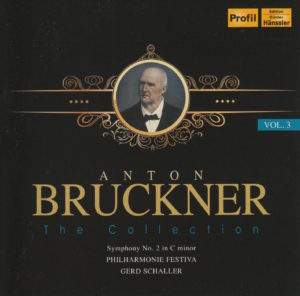 This morning’s conductor of Anton Bruckner’s Symphony No. 2 in C Minor (WAB 102) is Gerd Schaller (1965-), a German conductor highly regarded for recording Bruckner’s works, especially Bruckner’s rarer, less-recorded compositions.
This morning’s conductor of Anton Bruckner’s Symphony No. 2 in C Minor (WAB 102) is Gerd Schaller (1965-), a German conductor highly regarded for recording Bruckner’s works, especially Bruckner’s rarer, less-recorded compositions.
The orchestra is Philharmonie Festiva, which is also of high distinction, according to its entry on Wikipedia:
The international fame of the Philharmonie Festiva grew with its recordings of all Anton Bruckner’s symphonies, including several versions never before heard. The recordings were made in the Cistercian Abbey in Ebrach and formed part of the Bruckner cycle performed at the Ebrach Summer Music Festival.
 I first encountered Gerd Schaller by accident when I opened the Bruckner Collection box set. Schaller, alphabetically, should not follow Chailly and come before Gielen. But, because the box set is called Bruckner Collection, and I’m taking these symphonies alphabetical by conductor name by box set, I put this under “C” for “Collection.” And “Collection” would, most definitely, follow Chailly – alphabetically speaking, of course.
I first encountered Gerd Schaller by accident when I opened the Bruckner Collection box set. Schaller, alphabetically, should not follow Chailly and come before Gielen. But, because the box set is called Bruckner Collection, and I’m taking these symphonies alphabetical by conductor name by box set, I put this under “C” for “Collection.” And “Collection” would, most definitely, follow Chailly – alphabetically speaking, of course.
So that’s why Gerd Schaller follows Riccardo Chailly.
First up, the objective aspects of this recording:
Bruckner’s Second Symphony
Gerd Schaller conducts
Philharmonie Festiva plays
The version used is 1872, “Edition Carragan” (whatever that means)*
The symphony clocks in at 70:29
This was recorded in 2011 at Abteikirche Ebrach (Abbey)
Schaller was 46 when he conducted it
Bruckner was 48 when he composed it
Bruckner wrote his symphonies in four parts. The time breakdown of this one (Symphony No. 2 in C Minor, Carragan version), from this particular conductor (Schaller) and this particular orchestra (Philharmonie Festiva) is as follows:
Allegro……………20:51
Adagio……………10:58
Scherzo………….17:56
Finale………………20:36
Schaller’s interpretation of Bruckner’s Symphony No. 2 in C Minor is longer than Chailly’s by about 10 minutes.
I clearly heard the pizzicato passages this time – in three different movements: Allegro (around the 7-minute mark), Scherzo (around the the 3-minute mark), and Finale (around the 7-minute mark). I don’t know what it is about pizzicato that puts a smile on my face. I think it’s that pizzicato is used in cartoons when one character is tip-toeing up on another.
* Carragan is William Carragan, a Brucknerian scholar of note. An explanation of his choices of Bruckner versions can be found here. It’s a pdf. So feel free to download it and read it at your leisure.
A list of the versions and editions of Bruckner’s symphonies and their editors can be read here. It’s essential if you want to know what you’re listening to.
Okay. Now for the subjective aspects to this morning’s listening:
My Rating:
Recording quality: 5
Overall musicianship: 5
CD liner notes: 0 (there are none!)
How does this make me feel: 5
There’s something quite intriguing about Gerd Schaller’s interpretations and conducting skills. He seems to have a light, almost lyrical touch. This interpretation of Bruckner’s Symphony No. 2 in C Minor is gentle, soft – but then, as in the opening to Finale – rushes in with a surprising power and eloquence.
The end result is a listening experience that I found hard not to enjoy.
If this Bruckner Collection had (a) a sturdier box to hold all 20 CDs, and (b) a booklet explaining what all of this music is, including bios of who performed and conducted it, it would be a remarkable box set, indeed.
